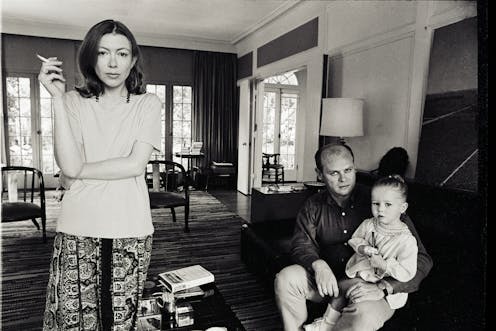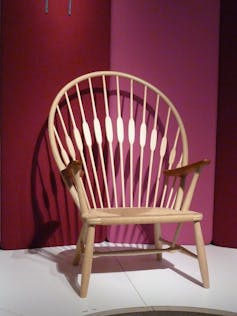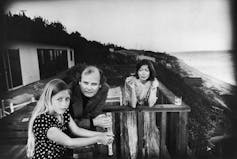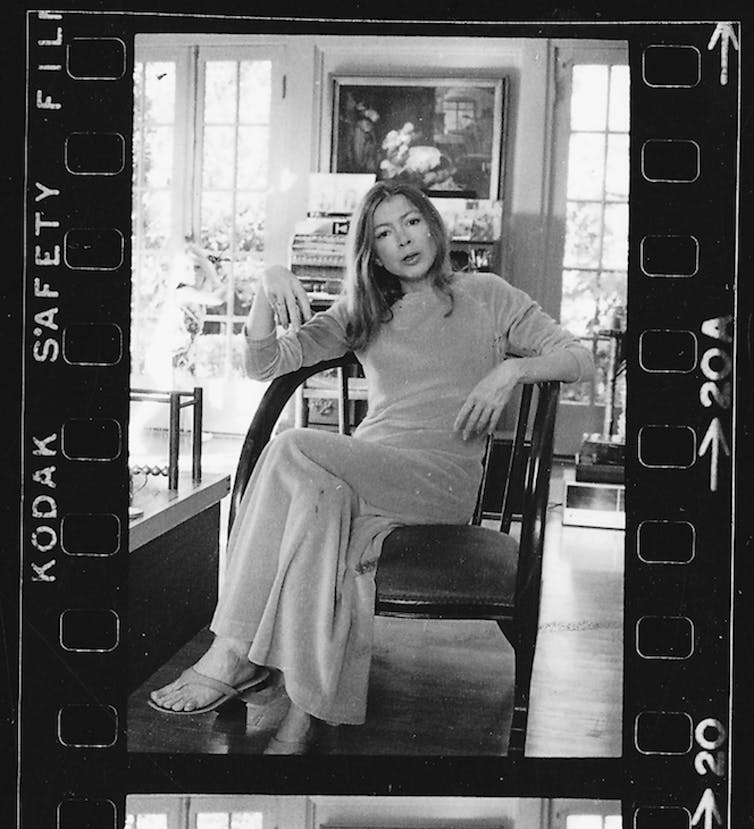
There are few writers as visually distinctive as Joan Didion. We have glimpses of her as a young reporter with her delicately poised silk scarf and anorak. A decade later we see her on the porch of her Malibu home, casting an ironic glance at her partner and daughter in the foreground, the Pacific Ocean fading out cinematically behind them.
These images are part of the selling power of the grand narrative fiction of Joan Didion – an image that evokes an era when a life in writing might naturally distil glamour. Whole generations of writers continue to make themselves in the fantasy of her image, though the affordances of a life in writing are no longer what they were.

The acquisition of Didion’s brand has now been made more possible with the auction of her possessions at the Stair Galleries in Hudson, New York. Here we find the black-and-white photograph of Didion with her Corvette in Malibu and her peacock chair, popularised by 1960s counterculture, and the Bay Area retailer Cost Plus. The peacock chair would become a political symbol of black liberation but for Didion, it was simply the style of 1960s California, the dream of revolution refashioned as elite homeware design.

For all her cool minimalism and adamantine individualism, Didion, who was known to host elaborate dinner parties, was invested in the idea of the domestic. Bidders can now experience the Didion concept by purchasing one of her Limoges porcelain fish service plates, an apron that says “Maybe broccoli doesn’t like you either”, or a yellowing white Le Creuset Dutch oven. In an essay published in her second collection The White Album, Didion sardonically remarks that she “felt like the heroine of Mary McCarthy’s Birds of America, the one who located America’s moral decline in the disappearance of the first course”.
These items, which were originally priced at their market value, have increased exponentially in the two-week bidding period. Didion’s empty notebooks currently stand at a hundred times their retail value.
Becoming Joan
Born in 1934 to middle-class Sacramento Republicans, Didion was part of the old Californian elite, a position that distinguished her from the liberal tones of mid-century journalism. “The New York Times brings out in me only unpleasant agrarian aggressions”, she wrote in an essay, noting her preference for underground women’s journalism and The Wall Street Journal. Her taste is in keeping with her lifestyle and generation, which her partner, John Gregory Dunne, described as “post-war Malibu.”

Didion began her career writing for Vogue and the National Review. These two engines of American cultural elitism were perfectly suited to Didion’s brand, which she argued was grounded in a “moral hardness”, a quality that she located, too, in the books of George Orwell, Joseph Conrad and Norman Mailer, which can also be purchased as the greatest hits of the Didion library.
Didion, who prided herself on the legacy of her Californian self-reliance, was never shy of making money. She tested the market for her belongings during the Kickstarter campaign for her 2017 documentary The Center Will Not Hold, directed by her nephew Griffin Dunne. Offerings included $350 USD to have the author read a two-page letter, $35 for a handwritten list of her 12 favourite books, $50 for a pdf copy of her recipe book, and $2,500 for a pair of sunglasses from her personal collection.
Didion’s shadowy identity
Having spent much of her middle decades among Hollywood actors, Didion was too good at her game to give anything away. The closer you look at the writer, the further she, like the wily protagonists of her novels, recedes from view. It was a trick that she acknowledged in the preface to her first collection Slouching Towards Bethlehem: “My only advantage as a reporter is that I am so physically small, so temperamentally unobtrusive…that people tend to forget that my presence runs counter to their best interests”.

In a 1970s article for Esquire, Didion paints a picture of herself as a 20-something-year-old writer at Vogue in the 1950s who dreams of setting up a shopping centre and running it out of her “pale blue office”.
Didion gave up her mall dreams to produce a more marketable commodity: her own literary persona, who chronicles the American worlds that are unravelling at the seams everywhere she turns. In her best, though least read work, Democracy, published the year of Orwell’s dystopian vision of the future, she appears as the character “Joan Didion” who holds together a late imperial map of a country that has turned up an explosive blind alley.
Most aspiring young writers will be unable to afford the Didion memorabilia they covet, but in the New York Times’s promise ahead of the auction – that fans can “acquire a piece of her legacy” – the dream of writing, and of California, is offered up anew.
Jess Cotton receives funding from the Leverhulme Trust.
This article was originally published on The Conversation. Read the original article.







